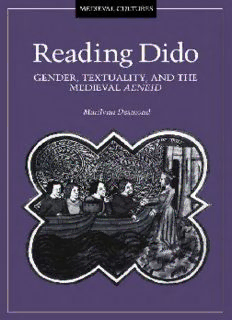Table Of ContentReading Dido
MEDIEVAL CULTURES
SERIES EDITORS
Rita Copeland
Barbara A. Hanawalt
David Wallace
Sponsored by the Center for Medieval Studies
at the University of Minnesota
Volumes in the series study the diversity of medieval cultural histories and
practices including such interrelated issues as gender, class, and social hierar-
chies; race and ethnicity; geographical relations; definitions of political space;
discourses of authority and dissent; educational institutions; canonical and
noncanonical literatures; and technologies of textual and visual literacies.
VOLUME 8
Marilynn Desmond
Reading Dido: Gender, Textuality, and the Medieval Aeneid
VOLUME/
Edited by Clare A. Lees
Medieval Masculinities: Regarding Men in the Middle Ages
VOLUME 6
Edited by Barbara A. Hanawalt and Kathryn L. Reyerson
City and Spectacle in Medieval Europe
VOLUME 5
Edited by Calvin B. Kendall and Peter S. Wells
Voyage to the Other World: The Legacy of Sutton Hoo
VOLUME 4
Edited by Barbara A. Hanawalt
Chaucer's England: Literature in Historical Context
VOLUME 3
Edited by Marilyn J. Chiat and Kathryn L. Reyerson
The Medieval Mediterranean: Cross-Cultural Contacts
VOLUME 2
Edited by Andrew MacLeish
The Medieval Monastery
VOLUME 1
Edited by Kathryn Reyerson and Faye Powe
The Medieval Castle
Reading Dido
GENDER, TEXTUALITY, AND THE MEDIEVAL AENEID
Marilynn Desmond
Medieval Cultures
Volume 8
University of Minnesota Press
Minneapolis
London
Copyright 1994 by the Regents of the University of Minnesota
Parts of this book have been previously published, in slightly different form, as
"When Dido Reads Vergil: Gender and Intertextuality in Ovid's Heroides 7,"
Helios (1993), reprinted with permission of Helios-, and "Bernard Silvestris and
the Corpus of the Aeneid," in The Classics in the Middle Ages, Medieval &
Renaissance Texts & Studies 69 (Binghamton, N.Y., 1990), 129-39, copyright
Center for Medieval & Early Renaissance Studies, State University of New York
at Binghamton, reprinted with permission.
All rights reserved. No part of this publication may be reproduced, stored in a
retrieval system, or transmitted, in any form or by any means, electronic,
mechanical, photocopying, recording, or otherwise, without the prior written
permission of the publisher.
Published by the University of Minnesota Press
111 Third Avenue South, Suite 290, Minneapolis, MN 55401-2520
Printed in the United States of America on acid-free paper
Library of Congress Cataloging-in-Publication Data
Desmond, Marilynn, 1952-
Reading Dido : gender, textuality, and the medieval Aeneid / Marilynn
Desmond.
p. cm. — (Medieval cultures : v. 8)
Includes bibliographical references (p.) and index.
ISBN 0-8166-2246-9.— ISBN 0-8166-2247-7 (pbk.)
1. English literature—Roman influences. 2. English literature—Middle
English, 1100-1600—History and criticism. 3. French literature—To 1500—
History and criticism. 4. Literature, Medieval—History and criticism.
5. Dido (Legendary character) in literature. 6. Carthage (Extinct city)—In litera-
ture. 7. Literature, Medieval—Roman influences. 8. Sex role in literature.
9. Queens in literature. 10. Virgil. Aeneis.
I. Title. II. Series.
PR127.D47 1994
809'.93351—dc20 94-6447
The University of Minnesota is an
equal-opportunity educator and employer.
To G. J. K.
—for the age of miracles hadn't passed—
Frontispiece: Aeneid 4 incipit: top left, Mercury; bottom left, Dido pleads with Aeneas;
upper right, Aeneas departs,- bottom right, Dido's suicide. Lyons, Bibliotheque municipale,
Palais des Arts 17, Aeneid fol. 108r. Fifteenth century. By permission.
But I would have dared to be Dido. This is where I begin to suffer in
a woman's place. Reading Virgil again, in the Aeneid (Books 3 and 4);
one sees how the venerable Aeneas, who is destined to found a city, is
kept from the feminine danger by the gods.
Less of a bastard than Jason, less "pure" in plain, brute jouissance
than Theseus, more moral; there is always a god or a cause to excuse or
explain Aeneas' skill at seeding and shaking off his women, dropping
them. . . .
Mercury who is sent by Jupiter intervenes in the name of the league
of empire builders: so you are building a beautiful city for a woman and
forgetting your kingdom and your own destiny} Thus pious Aeneas will
be saved from shame. The next scenes would have been unbearable for
him; grief, love, and Dido's beauty are mingled in heartrending songs,
and Aeneas doubtless would have weakened. But "the fates are against
it, and a god closes the hero's serene ears." He hurts, but he has his law,
and that is what he espouses: and his law is clear, because, by dying,
Creuse is giving him a sublime strength. The good love for man is his
country, the fatherland. A masculine land to hand down from father to
son. For Ascanius then. . . .
In Dido's place. But I am not Dido. I cannot inhabit a victim, no
matter how noble. I resist: detest a certain passivity, it promises death
for me. So, who shall I be} I have gone back and forth in vain through
the ages and through the stories within my reach, yet find no woman
into whom I can slip. My sympathy, my tenderness, my sorrow, how-
ever, are all hers. But not me, not my life. I can never lay down my
arms.
Helene Cixous, The Newly Born Woman
This page intentionally left blank
Contents
Preface xi
Abbreviations xv
Introduction
Gender and the Politics of Reading Virgil 1
1. Dux Femina Facti: Virgil's Dido in the Historical Context 23
2. Dido as Libido: From Augustine to Dante 74
3. Dido in Courtly Romance and the Structures of History 99
4. Sely Dido and the Chaucerian Gaze 128
5. Dido's Double Wound in Caxton's Eneydos and
Gavin Douglas's Eneados 163
6. Christine de Pizan's Feminist Self-Fashioning and
the Invention of Dido 195
Epilogue
On Reading Dido 225
Notes 229
Select Bibliography 281
Index 289
IX

